Peter Spier’s People, first published in 1980, remains one of the best books for children ages three to seven on the topic of diversity. Spier’s delightful, colorful drawings dominate the 48 pages of this oversized (9.75” x 13”) book. There is some text to be read aloud by parents and discussed with children, although children will still want to pour over the detailed illustrations on their own.
Spier focuses on diversity in a manner very appropriate for young children. He doesn’t address gender or sexual preferences as do many of the more recent books on this topic. Instead, Spier talks about differences in individuals such as the color and shape of their eyes, their skin color, and their hair (or lack of it). He talks about differences between cultures, their clothing styles, their houses, and their ideas about what is beautiful. He talks about personal preferences that vary such as those who love noise and those who prefer quiet, those who love crowds and those who prefer to be alone. He illustrates and identifies different types of pets, holidays around the world, regional foods, different religions, and different languages.
Granted, since the book is almost 40 years old, some images, such as those related to technology, are out of date. This shouldn’t matter to children, although it might give you opportunities to discuss technological changes such as those with televisions and telephones.
People is a celebration of diversity, but it includes subtle moral messages when it discusses people who might be kind or unkind, hard-working or lazy, wise or foolish, and a few other distinctions about characteristics over which the individual has control. At the end, Spier contrasts a bland city where buildings, people, and activities lack color and diversity with a lively multicultural city that’s bursting with variety, color, and activity. Clearly, the latter is much more appealing, and that’s the message of this book.
Children do need to learn about diversity, and People is an excellent way to introduce the topic.









